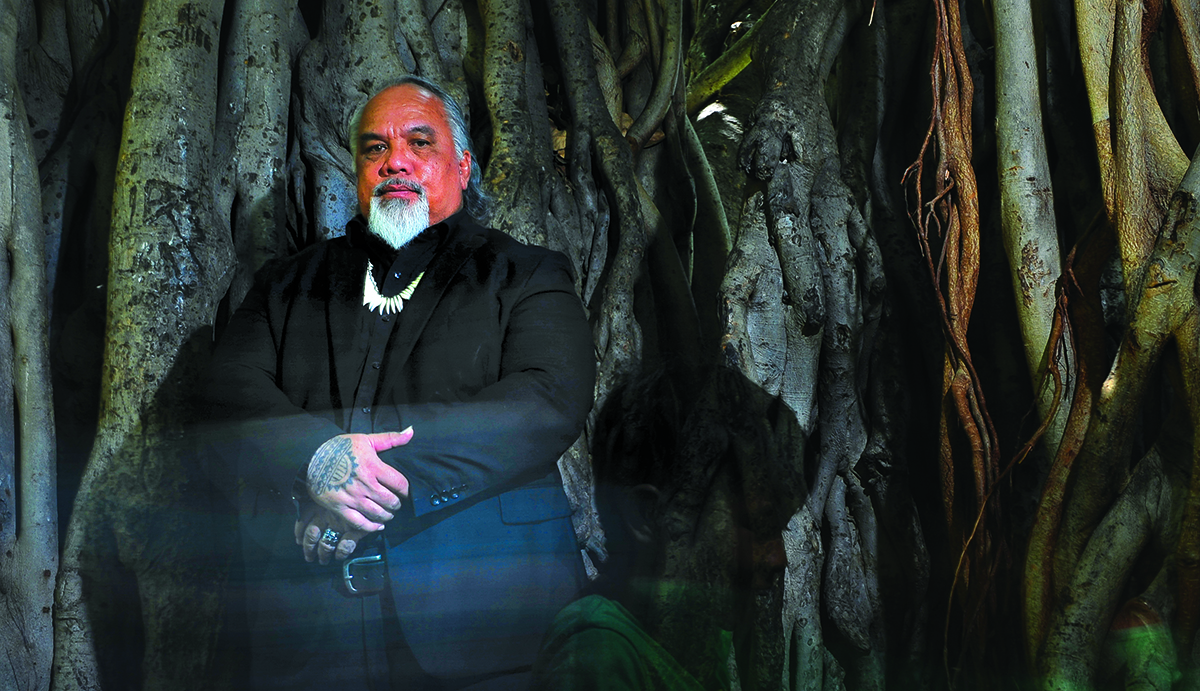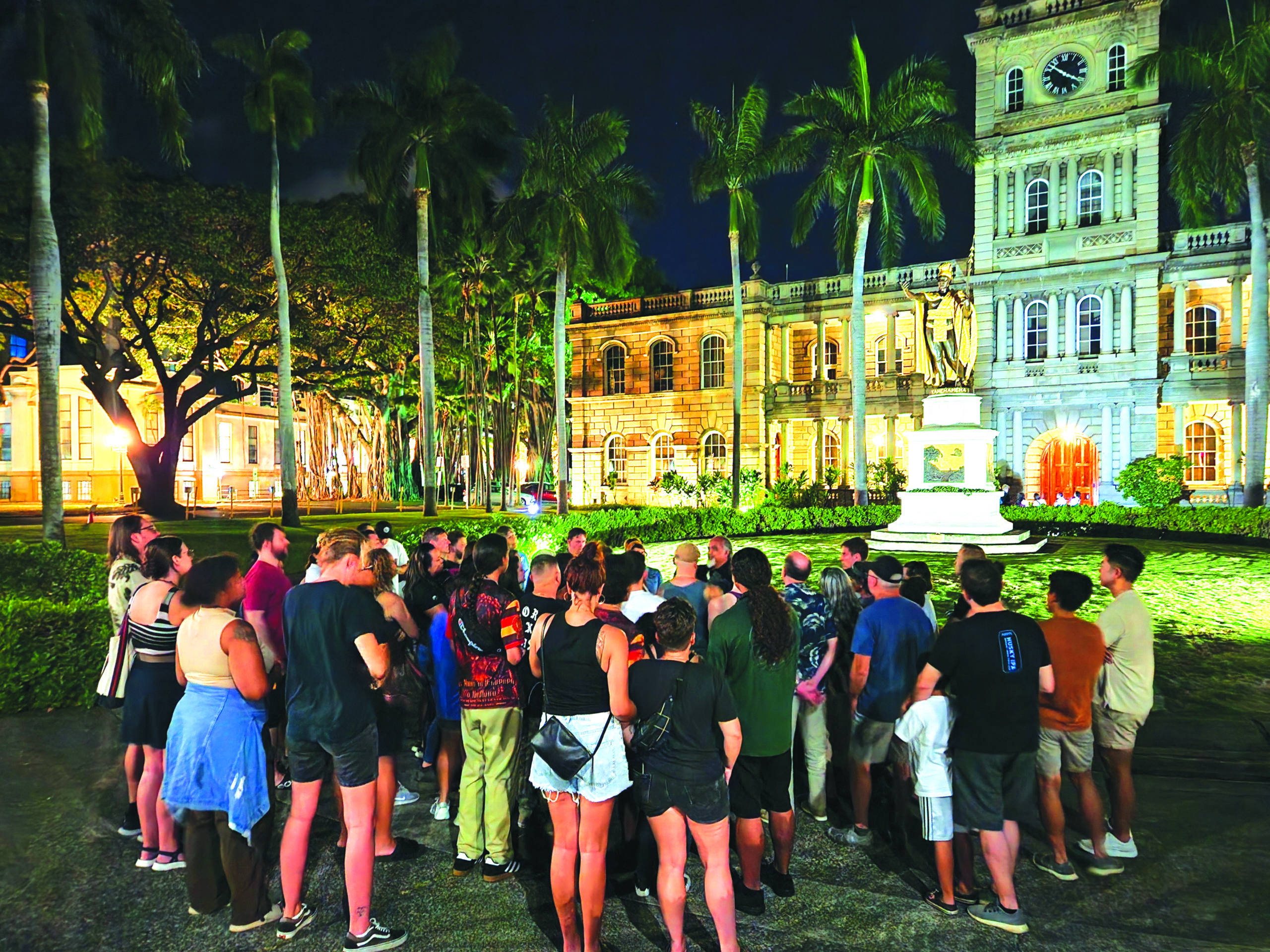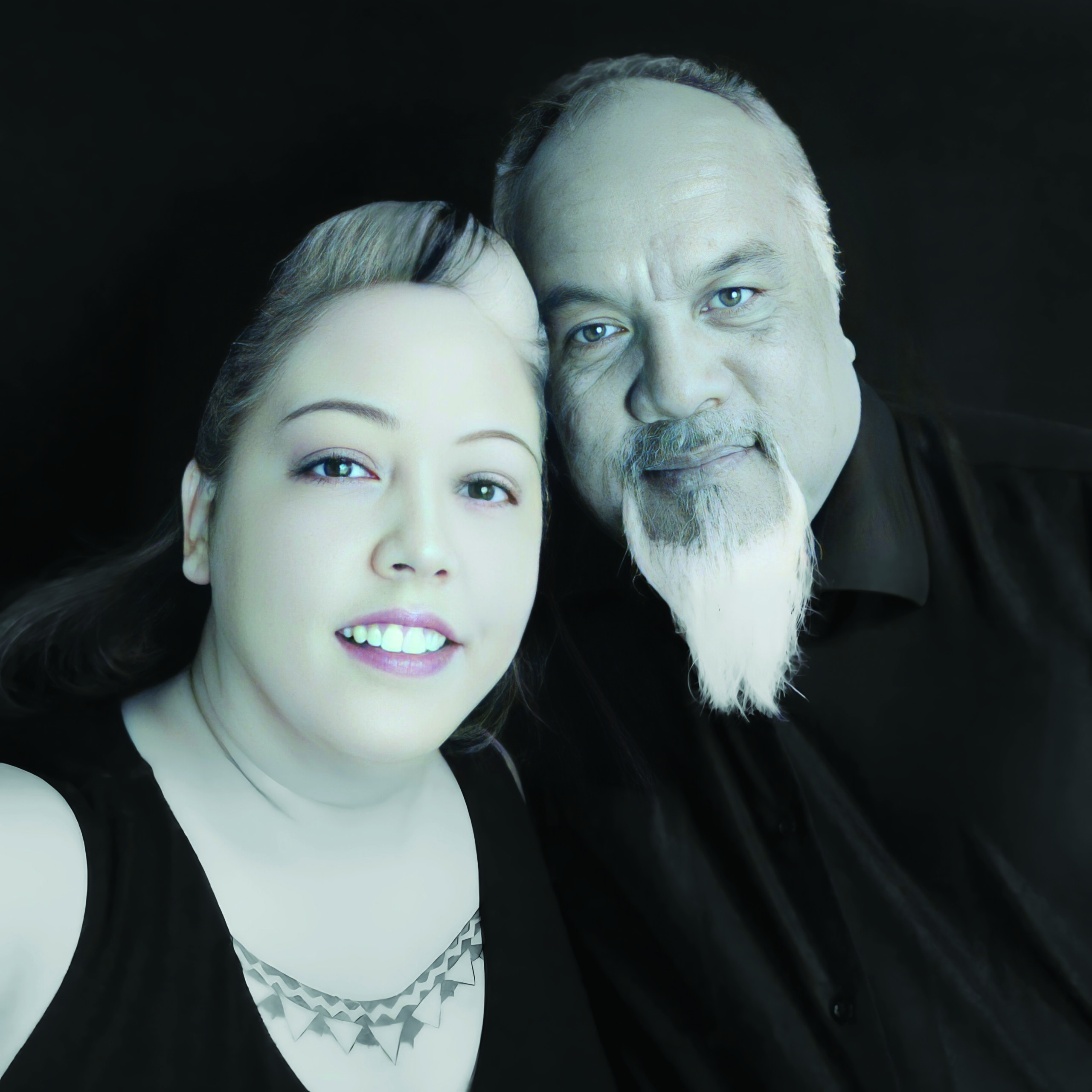Spirited storyteller
Staring at the ceiling of the old Kauikeōlani Children’s Hospital, a 7-year-old Lopaka Kapanui heard a commotion from behind the curtain in his shared room. At this point, he’d been lying in a hospital bed for months, recovering from a complex kidney operation. It wasn’t long before he became friends with Scotty Boy, the patient in the bed beside him. Scotty’s parents were visiting, and the doctor was there, too.
Curious by nature, Kapanui tried to make sense of the adults’ voices, which all of a sudden turned to cries. When the room cleared, Kapanui saw Scotty rise from the bed and walk over to his side of the partition.
“‘Let’s play, friend. C’mon, friend, let’s play,’” Kapanui remembers Scotty saying.
Just as he began to dangle his feet over the side of the bed, his grandmother, Mary, who had been sitting in a chair in the corner of the room, exclaimed, “No! Don’t get off that bed. Didn’t you pay attention to what was just happening? That boy just died. That’s why they’re all crying. If you get off that bed and your feet touch that floor and you play with that boy, you’re never coming back.”

Lopaka Kapanui. PHOTO BY LAWRENCE TABUDLO
While that was certainly an odd thing for his grandma to say, it wasn’t unusual for her to visit. She would sit with Kapanui nearly every day, wearing her usual glasses and mu‘umu‘u, to keep him company until his parents arrived.
“When I was good enough to go home, my parents were asking me about what happened and if I made any friends,” the Wai‘anae native remembers. “I said I did and that Grandma Mary would come every day and talk with me. They looked at me and I remember my mom asking me what she was wearing. I said, ‘Oh, you know, those glasses with the string underneath and a mu‘umu‘u that was black with white flowers on it.’ She looked at my father … and they told me that while I was in the hospital, she actually passed away and they went to the Big Island for the services. They didn’t want to tell me because they knew how close I was with her.”
Around the same time, Kapanui also learned that, for just a few seconds, he had died after his heart stopped during surgery.
“When I got back, that’s when I could see, hear and feel everything,” he says.
What began on that fateful day in the children’s hospital led to a lifetime of paranormal perception, which Kapanui didn’t lean into until adulthood. Yet even as a child, he was enthralled by Hawaiian legends he learned from his ‘ohana or by “ferociously absorbing” books in the library.
“For some reason, those legends were very fascinating because as they were being told to me, I was there,” he says. “I could see the sights, smell the aromas — everything. I would become totally transported. The legends didn’t seem like they were folklore or fantasy.”

Master storyteller Lopaka Kapanui operates the longest-running and only Native Hawaiian-owned ghost tours on O‘ahu, and takes participants to haunted sites, including Paradise Park in Mānoa. PHOTOS COURTESY LOPAKA KAPANUI.
It wasn’t until he spontaneously joined a ghost tour — led by University of Hawai‘i professor Glen Grant, writer of the Chicken Skin Tales ghost story anthologies — that Kapanui realized he could turn his calling into something more. Grant became his mentor — the two would drive around the island visiting haunted sites together — until Grant’s death in 2003, when Kapanui stepped into the role, “whether I liked it or not,” he says with a laugh.
“(Glen) said, ‘You can read some of my stories from my books, but what I want you to do is gather your own stories and make this your own thing,’” Kapanui says. “He said, ‘I don’t want you to be me. If you do this, you need to make it your own. That’s the way this is going to work.’ He also said something that stuck with me and I say to myself now: ‘Remember, the people you do this for have to trust you. Don’t lie. Don’t make things up. Because they’ll figure it out.’”
Following Grant’s death, Kapanui carried the ghost-tour torch but, due to some unfortunate circumstances, became homeless, though he never missed a tour.
“The only thing I had to keep me floating was the ghost stories. It means a lot more to me than just a business; it was something that was literally saving my life,” he says.
Fortunately, life got better when he met his wife, Tanya, on one of his tours. He brought her and others in a group to the O‘ahu Cemetery and requested there be no photos taken until he gave permission. Just as the words exited his mouth, Tanya snapped a pic and a big, blinding flash went off.
“I looked over and I said, ‘Hey! I just said not to take any photos!’ After it was over, I apologized to her and we became friends and eventually more. But I remember the first time I locked eyes with her. This voice internally said, ‘If you want to be with that woman, there’s some things about yourself you’re going to have to change.’”

Tanya and Lopaka Kapanui are the experts behind Hawai‘i’s Night Marchers: A History of the Huaka‘i Pō, available now on Amazon.
PHOTO COURTESY LOPAKA KAPANUI.
Once married, Tanya took over the business side of things and now “basically runs everything,” according to Kapanui. Thanks to her expert marketing, word got out about Kapanui and his spiritual sensitivity/historical knowledge, and he’s been asked to guest star on podcasts and reality TV shows and even consulted on motion pictures like Netflix’s hit movie Finding ‘Ohana.
When the pandemic rolled around, Kapanui took his storytelling skills to the virtual world and live streamed on YouTube, Facebook and Instagram certain days of the week, garnering an entirely new online audience. He also had a ton of time to author some more books.
Kapanui’s fifth book, Hawai‘i’s Night Marchers: A History of the Huaka‘i Pō, is his first collaboration with Tanya. Released earlier this year, the book is basically a night marchers encyclopedia, taking readers on a journey from the inception of Hawaiian cosmology till now, and includes more than four dozen eyewitness testimonies.
Kapanui shares his own encounter: “I was taking a group of people up to the Mānoa Cemetery … and all of a sudden, this wind just tears through the cemetery. It’s bending all the trees in one direction and you can see all the dry leaves kicking up. What I noticed was even though I could see the wind, I couldn’t hear it or feel it, and I felt very warm and encapsulated. I look at the people and they’re all running back to the bus.
“The next day I called my cousin and told him what happened, and he said, ‘Last night was one of the night marcher moons and that’s where they come to, right through there. You might’ve been standing in the middle of the procession.’ I asked him how come I wasn’t killed, and he said, ‘That feeling you had about being warm and encapsulated, you must’ve had an ancestor in that procession who recognized you and surrounded you and protected you as the rest of them passed by.’”
Paranormal occurrences aren’t uncommon for Kapanui, who leads ghost tours nearly every night. October is an especially busy month for him, with Halloween nearing soon. Seekers of all things spooky can join Kapanui in downtown Honolulu, Mānoa or Waikīkī for an eerie excursion to learn about Hawaiian gods and goddesses, legends of spirits and demigods, stories of mystery and hauntings, and more. He also holds ghost story concerts at local theaters and sometimes visits the neighbor islands. For all of his events, though, the goal is to never scare participants — no intentional jump scares here — but rather to open their minds and invite them to learn about a new world. Chicken skin is almost always a guarantee.
“(The tours) are basically to learn about when or why or how spirits communicate to us,” he explains. “That’s essentially what it is — whittling away misunderstandings so we can get to the core of the truth, which is: There’s nothing to fear with something that’s just trying to communicate. But because of social media and movies, we’ve been conditioned to believe that ghosts and spirits are evil and they’re after us and they’re trying to possess our bodies. That’s been so ingrained into us for so many years that it prevented us from understanding that this is communication.
“Even though a person has passed away, the person’s personality is still the same. If you can communicate with a spirit, you can talk to it like it’s still a person. A woman asked me a couple nights ago, ‘If my uncle was a jerk when he was alive, is he an angel when he passes away?’ And I said, ‘No, he’s still a jerk,’” Kapanui adds with a laugh.
Coming up, Kapanui teases that he has a few films in the works, plus a five-part novel about a generation of healers from ancient to current times. In the meantime, he’s more than content giving tours and being known as Hawai‘i’s token “Ghost Guy.”
“We’re eventually going to get to the point where I’m going to find someone or a couple of people to do these tours. It can’t be just anyone,” Kapanui says. “In Buddhism, they always say the student finds the teacher, so I gotta wait.”




